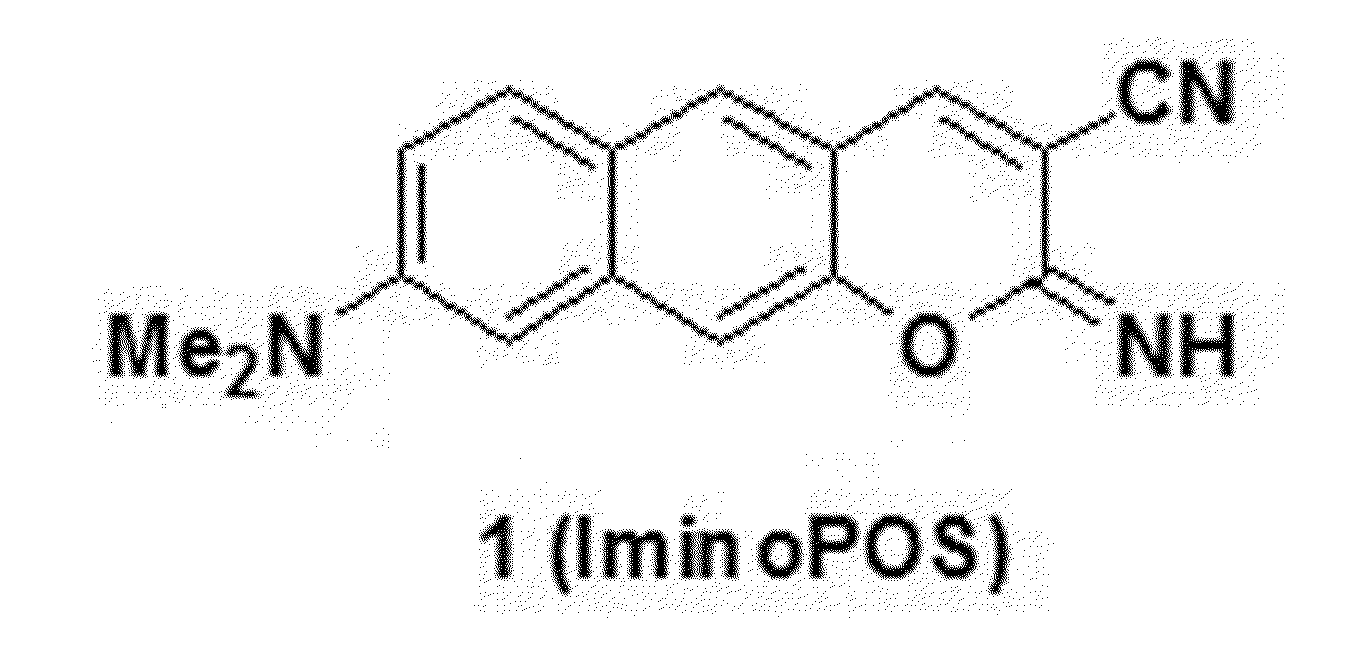Novel two-photon absorbing fluorescent substance, and substrate sensing method using same
- Summary
- Abstract
- Description
- Claims
- Application Information
AI Technical Summary
Benefits of technology
Problems solved by technology
Method used
Image
Examples
example 2
Confirmation of Fluorescence Characteristic of Compound 1 of Chemical Formula 1
[0067]The present inventors confirmed optical characteristics of the compound 1, which were illustrated in FIGS. 1, 2, and 3.
[0068]The present inventors used acedan and coumarin 153 as a comparative group when confirming the optical characteristics of the compound 1. The optical characteristics were measured at a concentration of 10 μM in an ethanol solvent. Quantum yield (ΦF) and two-photon absorption cross-section (GM) values were measured based on Rhodamine 6G (ΦF=0.6, GM=700). The compound 1 had an excitation wavelength of 446 nm and an emission wavelength of 585 nm. In addition, the compound 1 had high quantum yield of 0.67 and GM=126. On the contrary, acedan had the excitation wavelength of 365 nm and the emission wavelength of 501 nm, and coumarin 153 had the excitation wavelength of 425 nm and the emission wavelength of 548 nm. FIG. 2 arranges the respective optical characteristics, and FIG. 3 ill...
example 3
Synthesis of Compounds of Chemical Formulas 3 and 4
[0070]A general synthesis path was illustrated in the following Scheme 2.
[0071](1) Synthesis of 6-dimethylamino-3-{3-[N,N-bis(tert-butyloxycarbonyl)amino]propyloxy}naphthalene-2-carbaldehyde (compound 9a in Scheme 2)
[0072]The present inventors performed a synthesis of 6-dimethylamino-3-{3-[N,N-bis(tert-butyloxycarbonyl)amino]propyloxy}naphthalene-2-carbaldehyde.
[0073]In detail, 176.6 mg (0.82 mmol) of a compound of Chemical Formula 2, 242 mg (0.82 mmol) of N-tert-butyloxycarbonyl-3-(chloropropyl)carbamic acid tert-butyl ester, and 227 mg (1.64 mmol) of potassium carbonate were dissolved in 5 mL of DMF in a 25 mL round-bottom flask. The mixture was stirred at 50° C. for 27 hours. After 27 hours, the mixture was cooled at room temperature, and an extraction process was performed using 100 mL of EtOAc, 100 mL of water, and 100 mL of saturated salt water. The organic layer (EtOAc) obtained through the extraction was concentrated by dry...
example 4
Confirmation of Fluorescence Characteristics of Compounds of Chemical Formulas 1, 3, and 4
[0089]The present inventors confirmed optical characteristics of the compounds 1, 3, and 4, and the optical characteristics were illustrated in FIG. 3.
[0090]The present inventors performed absorption and fluorescence emission experiments of the compounds 1, 3, and 4 in a buffer solution (100 mM HEPES, pH 7.4 with 5% glycerol and 1% DMSO) at a concentration of 10 μM, respectively. As absorbance spectra, an HP 8453 UV / Vis spectrophotometer and a Photon Technical International Fluorescence System were used. As a cell for fluorescence measurement, a quartz cell of 1 cm was used. The fluorescence graph was measured with an excitation wavelength of 448 nm. The top of FIG. 3 is the absorbance spectra, and the bottom is the emission graph.
PUM
| Property | Measurement | Unit |
|---|---|---|
| Efficiency | aaaaa | aaaaa |
| Sensitivity | aaaaa | aaaaa |
| Stability | aaaaa | aaaaa |
Abstract
Description
Claims
Application Information
 Login to View More
Login to View More - R&D
- Intellectual Property
- Life Sciences
- Materials
- Tech Scout
- Unparalleled Data Quality
- Higher Quality Content
- 60% Fewer Hallucinations
Browse by: Latest US Patents, China's latest patents, Technical Efficacy Thesaurus, Application Domain, Technology Topic, Popular Technical Reports.
© 2025 PatSnap. All rights reserved.Legal|Privacy policy|Modern Slavery Act Transparency Statement|Sitemap|About US| Contact US: help@patsnap.com



